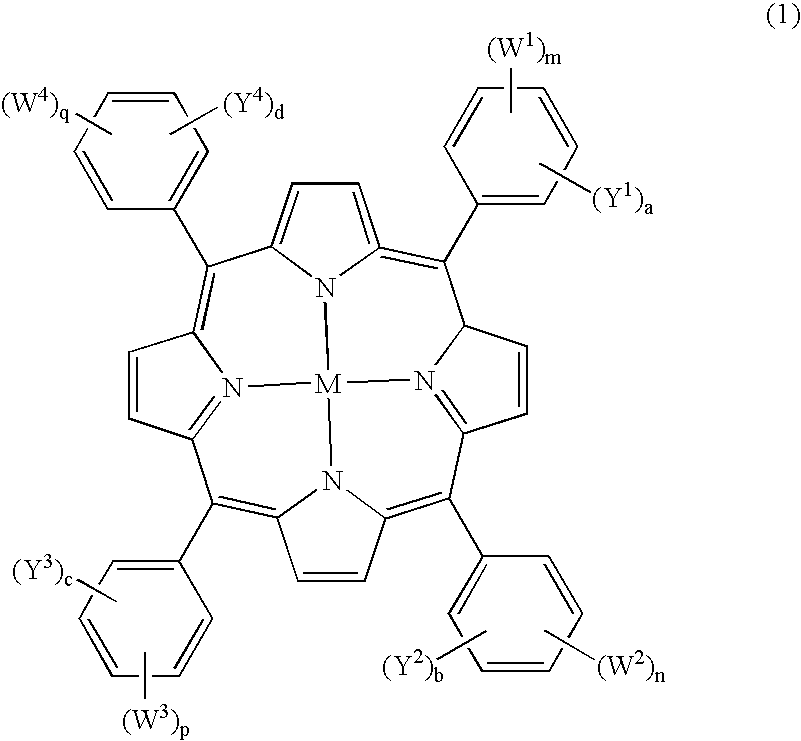Carboranylporphyrins and uses thereof
a carboranyl and porphyrin technology, applied in the field of carboranyl porphyrins, can solve the problems of limited efficacy of radiation and chemical methods in the treatment of cancer, reduced sensitivity of tumor cells, and increased toxicity of radiation and/or chemical treatments, so as to improve sensitivity, reduce toxicity, and increase polarity
- Summary
- Abstract
- Description
- Claims
- Application Information
AI Technical Summary
Benefits of technology
Problems solved by technology
Method used
Image
Examples
example 1
Synthesis of 3-methoxy-4-propargyloxybenzylalcohol (I)
[0083]Finely powdered K2CO3, 10.4 grams (0.075 moles), and KI, 9.1 grams (0.060 moles), were placed in a 300 mL round-bottomed flask equipped with a magnetic stir bar, and 150 mL acetone was added. 3-methoxy-4-hydroxybenzyl alcohol, 7.71 grams (0.050 moles), and propargyl chloride, 4.10 grams (0.055 moles), were then added, and the mixture stirred and refluxed for approximately 48 hours. The results from thin layer chromatography showed no starting material (3-methoxy-4-hydroxybenzyl alcohol) as well as the presence of a new compound. The solution was then filtered. The acetone of the resulting filtrate was removed by rotary evaporation, leaving an oily residue. The oily residue was dissolved in 50 mL dichloromethane and washed with water (30 mL×2) and then dried over anhydrous potassium carbonate. After filtering the organic phase, the solvents were removed by rotary evaporation, leaving a liquid product. 9 grams of product was ...
example 2
Synthesis of 3-methoxy-4-propargyloxybenzyl acetate (II)
[0085]Acetyl chloride, 1.38 grams (0.0176 moles), was dissolved in 10 mL of pyridine in a 100 mL round flask cooled in an ice bath. A solution of 3-methoxy-4-propargyloxybenzylalcohol (I), made by dissolving 2.82 grams (0.0146 moles) of (I) in 15 mL pyridine, was added dropwise into the flask. The mixture was stirred for five hours, after which time the solvent was removed by rotary evaporation. The resulting residue was cooled to room temperature, and then dissolved in dichloromethane (30 mL). The organic phase was washed with aqueous 3N HCl and then water and dried over anhydrous magnesium sulfate. After filtering, the solvent of the organic phase was removed by rotary evaporation, leaving a yellow oil, which solidified upon standing. Recrystallization in methanol yielded 2.91 grams of the white crystalline solid, which corresponds to an 85% yield.
[0086]The product had a melting point of 69–71° C. and gave the following 1H NM...
example 3
Synthesis of 3-methoxy-4-o-oxymethylcarboranylbenzyl acetate (III)
[0087]Decaborane, 2.07 grams (0.017 moles), was stirred in 100 mL of toluene in a 250 mL round-bottomed flask at room temperature under an argon atmosphere. Acetonitrile, 2.1 mL (0.040 moles), was added by syringe. The mixture was allowed to stir for three hours. 3-methoxy-4-propargyloxybenzyl acetate (II), 3.82 grams (0.0163 moles), was then added, and the mixture slowly heated to 80–90° C. The mixture was maintained at a temperature of 80–90° C. under an argon atmosphere for three days, after which time the results from thin layer chromatography showed the no presence of starting material (II) as well as the presence of a new compound. The solvents from the mixture were then removed by rotary evaporation. The resulting residue was dissolved in 50 mL of dichloromethane, which was washed with 20 mL of 10% sodium bicarbonate and then twice with water (20 mL each), and then dried over anhydrous sodium sulfate. After fil...
PUM
| Property | Measurement | Unit |
|---|---|---|
| average energy | aaaaa | aaaaa |
| body weight | aaaaa | aaaaa |
| time | aaaaa | aaaaa |
Abstract
Description
Claims
Application Information
 Login to View More
Login to View More - R&D
- Intellectual Property
- Life Sciences
- Materials
- Tech Scout
- Unparalleled Data Quality
- Higher Quality Content
- 60% Fewer Hallucinations
Browse by: Latest US Patents, China's latest patents, Technical Efficacy Thesaurus, Application Domain, Technology Topic, Popular Technical Reports.
© 2025 PatSnap. All rights reserved.Legal|Privacy policy|Modern Slavery Act Transparency Statement|Sitemap|About US| Contact US: help@patsnap.com



